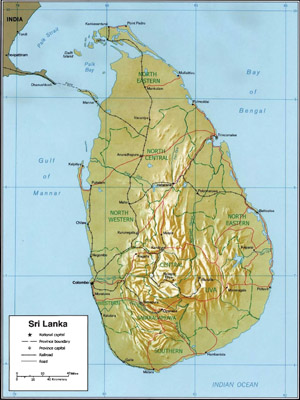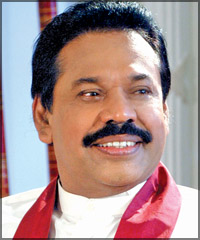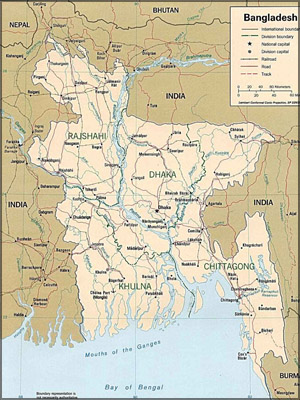|

Democratic Socialist Republic of Sri Lanka
Sri Lanka, officially the Democratic Socialist Republic of Sri Lanka
is an island nation located to the south of the Indian subcontinent. The
total land area is 65,610 sq. km. and is astonishingly varied.
 A length of 445 km. and breadth of 225 km. encompasses beautiful
tropical beaches, verdant vegetation, ancient monuments and a thousand
delights to please all tastes. A length of 445 km. and breadth of 225 km. encompasses beautiful
tropical beaches, verdant vegetation, ancient monuments and a thousand
delights to please all tastes.
The relief features of the island consist of a mountainous mass
somewhat south of the centre, with height exceeding 2,500 metres,
surrounded by broad plains. Palm fringed beaches surround the island and
the sea temperature rarely falls below 27AřC.
Because of its location in the path of major sea routes, Sri Lanka is
a strategic naval link between West Asia and South East Asia, and has
been a center of Buddhist religion and culture from ancient times.
Today, the country is a multi-religious and multi-ethnic nation with
faiths other than Buddhism, notably Hinduism, Christianity and Islam.
The Sinhalese community forms the majority of the population, with
Tamils, forming the largest ethnic minority. Other communities include
the Muslim Moors and Malays and the Burghers.
Famous for the production and export of tea, coffee, coconuts and
rubber, Sri Lanka boasts a progressive and modern industrial economy and
the highest per capita income in South Asia. The natural beauty of Sri
Lanka’s tropical forests, beaches and landscape, as well as its rich
cultural heritage, make it a world famous tourist destination.
Recent excavations show that even during the Neolithic Age, there
were food gatherers and rice cultivators in Sri Lanka. Very little is
known of this period; documented history began with the arrival of the
Aryans from North India.
The Aryans introduced the use of iron and an advanced form of
agriculture and irrigation. They also introduced the art of government.
Of the Aryan settlements, Anuradhapura grew into a powerful kingdom
under the rule of King Pandukabhaya. According to traditional history he
is accepted as the founder of Anuradhapura.
During the reign of King Devanampiya Tissa, a descendent of
Pandukabhaya, Buddhism was introduced in 247 B.C. by Arahat Mahinda, the
son of Emperor Asoka of India. This is the most important event in Sri
Lankan history as it set the country on the road to cultural greatness.
As a new civilisation flourished Sri Lanka became rich and prosperous.
In the mid 2nd century B.C. a large part of north Sri Lanka came
under the rule of an invader. From the beginning of the Christian era
and up to the end of the 4th century A.D. Sri Lanka was governed by an
unbroken dynasty called Lambakarna, which paid great attention to the
development of irrigation.
A great king of this dynasty, Mahasen (3rd century A.D.) started the
construction of large ‘tanks’ or irrigation reservoirs. Another great
`tank’ builder was Dhatusena, who was put to death by his son Kasyapa
who made Sigiriya a royal city with his fortress capital on the summit
of the rock.
As a result of invasions the kingdom of Anuradhapura fell by the end
of the 10th century A.D. Vijayabahu 1 repulsed the invaders and
established his capital at Polonnaruwa in the 11th century A.D.
Other great kings of Polonnaruwa were Parakrama Bahu the Great and
Nissanka Malla both of whom adorned the city with numerous buildings of
architectural beauty. Invasion was intermittent and the capital was
moved constantly until the Portuguese arrived in 1505, when the chief
city was established at Kotte, in the western lowlands.
The Portuguese came to trade in spices but stayed to rule until 1656
in the coastal regions, as did the Dutch thereafter. Dutch rule lasted
from 1656 to 1796, in which year they were displaced by the British.
During this period the highland Kingdom, with its capital in Kandy,
retained its independence despite repeated assaults by foreign powers
who ruled the rest of the country.
In 1815 the kingdom of Kandy was ceded to the British and thus they
established their rule over the whole island. Modern communications,
Western medical services, education in English, as well as the
plantation industry (first coffee then tea, rubber and coconut)
developed during British rule.
By a process of peaceful, constitutional evolution, Sri Lanka won
back her independence in 1948 and is now a sovereign republic, with
membership in the Commonwealth of Nations and the United Nations
Organisation.
The office of Prime Minister of Ceylon was created in advance of
independence on 14 October 1947, Don Stephen Senanayake being the first
prime minister. On February 4, 1948 the country won its independence as
the Commonwealth of Ceylon.
On July 21, 1960 Sirimavo Bandaranaike took office as prime minister,
and became the world’s first female prime minister and the first female
head of government in post-colonial Asia.
Sri Lanka is mainly an agricultural country. The chief crop is rice
with which the country is almost self sufficient. Tea, rubber and
coconut are also important agricultural crops, with tea being a major
foreign exchange earner.
In addition, other crops of importance are cocoa and spices such as
cinnamon, cardamom, nutmeg, pepper and cloves. Sri Lanka is also a major
exporter of precious and semi-precious stones. Within the last few years
remittances from Sri Lankans employed abroad have contributed a large
share towards foreign exchange.
The last three decades have seen tourism emerge as an important
industry. There has also been a rapid growth in manufacturing
industries.
***********
President Mahinda Rajapkasa
Born on November 18, 1945 Mahinda Rajapaksa is the current President
of Sri Lanka. A lawyer by profession, Rajapaksa previously served as the
country’s Prime Minister from April 6, 2004 until his swearing in as
President for a six-year term on November 19, 2005. He is married to
Shiranthi Rajapaksa, and is the father of three sons.
|

President Mahinda Rajapkasa |
Rajapaksa was born in Weerakatiya in the southern rural district of
Hambantota. He hails from a well known political family in Sri Lanka.
His father, D. A. Rajapaksa, was a prominent politician, independence
agitator and former Member of Parliament.
D.M. Rajapaksa, his uncle, was a State Councillor for Hambantota in
the 1930s who started wearing the earthy brown shawl to represent
kurakkan (finger millet) cultivated by the people of his area, whose
cause he championed throughout his life. It is from his example that
Rajapaksa wears his characteristic shawl.
Rajapaksa was educated at Richmond College, Galle before moving to
Nalanda College, Colombo and later Thurstan College, Colombo.
Following the death of his father in 1967, Rajapaksa took over as the
SLFP candidate for Beliatte constituency and was elected to Parliament
in 1970 as the youngest Member of Parliament at the age of 24. Later he
studied law at the Sri Lanka Law College and took oaths as an
attorney-at-law in November 1977.
In 1989 he was re-elected to Parliament to represent Hambantota
District under Proportional Representation.
In 1994, following the election victory of the People’s Alliance a
political front led by Sri Lanka Freedom Party and headed by Chandrika
Kumaratunga, Rajapaksa was appointed Minister of Labour.
After the Parliamentary Elections of 2004, in which the United
People’s Freedom Alliance was victorious, Rajapaksa was sworn in as Sri
Lanka’s 13th Prime Minister on April 6, 2004.
While Rajapaksa was the Prime Minister, he also held the Ministry of
Highways. He was elected Executive President in the nation-wide election
held in November 2005.
**************
Capital city : Sri Jayawardhanapura Kotte
Largest city : Colombo
Official languages : Sinhala, Tamil ann English
Denonym : Sri Lankan
Government : Democratic Socialist Republic
Independence : February 4, 1948
Area : 65,610 square km
Population : 18.5 million
GDP : $ 86.72 billion
Currency : Sri Lankan Rupee
People’s Republic of Bangladesh
The People’s Republic of Bangladesh is bordered by India on all sides
except for a small border with Myanmar to the far southeast and by the
Bay of Bengal to the south. Together with the Indian state of West
Bengal, it makes up the ethno-linguistic region of Bengal. The name
Bangladesh means ‘Country of Bengal’ in the official Bengali language.
 The borders of present-day Bangladesh were established with the
partition of Bengal and India in 1947, when the region became the
eastern wing of the newly-formed Pakistan. The borders of present-day Bangladesh were established with the
partition of Bengal and India in 1947, when the region became the
eastern wing of the newly-formed Pakistan.
However, it was separated from the western wing by 1,600 kilometres
across India. Political and linguistic discrimination as well as
economic neglect led to popular agitations against West Pakistan, which
led to the war for independence in 1971 and the establishment of
Bangladesh.
However, the new state had to endure famines, natural disasters and
widespread poverty, as well as political turmoil and military coups. The
restoration of democracy in 1991 has been followed by relative stability
and economic progress.
Bangladesh is among the most densely populated countries in the world
and has a high poverty rate. Geographically the country straddles the
fertile Ganges-Brahmaputra Delta and is subject to annual monsoon floods
and cyclones.
The government is a parliamentary democracy; however, political rule
has been suspended under emergency law since 11 January 2007. Bangladesh
is a member of the Commonwealth of Nations, SAARC, BIMSTEC, the OIC, and
the D-8.
As the World Bank notes in its July 2005 Country Brief, the country
has made significant progress in human development in the areas of
literacy, gender parity in schooling and reduction of population growth.
Remnants of civilisation in the greater Bengal region date back four
thousand years, when the region was settled by Dravidian, Tibeto-Burman,
and Austro-Asiatic peoples. The exact origin of the word ‘Bangla’ or
‘Bengal’ is unknown, though it is believed to be derived from Bang, the
Dravidian-speaking tribe that settled in the area around the year 1000
BC.
After the arrival of Indo-Aryans, the kingdom of Gangaridai was
formed from at least the seventh century BC, which later united with
Bihar under the Magadha and Maurya Empires.
Bengal was later part of the Gupta Empire from the third to the sixth
centuries CE. European traders arrived late in the 15th century, and
their influence grew until the British East India Company gained control
of Bengal following the Battle of Plassey in 1757.
Between 1905 and 1911, an abortive attempt was made to divide the
province of Bengal into two zones, with Dhaka being the capital of the
eastern zone. When India was partitioned in 1947, Bengal was partitioned
along religious lines, with the western part going to India and the
eastern part joining Pakistan as a province called East Bengal (later
renamed East Pakistan), with its capital at Dhaka.
Dissatisfaction with the Central Government over economic and
cultural issues continued to rise through the next decade, during which
the Awami League emerged as the political voice of the Bengali-speaking
population.
After its independence, Bangladesh became a parliamentary democracy.
In the 1973 Parliamentary Elections, the Awami League gained an absolute
majority.
A series of bloody coups and counter-coups in the following three
months culminated in the ascent to power of General Ziaur Rahman, who
reinstated multi-party politics and founded the Bangladesh Nationalist
Party (BNP). Zia’s rule ended when he was assassinated in 1981.
Bangladesh’s next major ruler was General Hossain Mohammad Ershad,
who gained power in a bloodless coup in 1982 and ruled until 1990, when
he was forced to resign under Western donor pressure in a major shift in
international policy.
Since then, Bangladesh has reverted to a Parliamentary democracy.
Zia’s widow, Khaleda Zia, led the Bangladesh Nationalist Party to
parliamentary victory at the General Election in 1991 and became the
first female Prime Minister in Bangladesh’s history.
However, the Awami League, headed by Sheikh Hasina, one of Mujib’s
surviving daughters, clinched power at the next election in 1996 but
lost to the Bangladesh Nationalist Party again in 2001.
These two female ex-prime ministers are now in imprisonment in a
sub-jail due to their suspected attachment with corruption. On January
11, 2007, following widespread violence, a Caretaker Government was
appointed to administer the next general election.
Bangladesh is divided into six administrative divisions, each named
after their respective divisional headquarters: Barisal, Chittagong,
Dhaka, Khulna, Rajshahi, and Sylhet. Divisions are subdivided into
districts (zila).
There are 64 districts in Bangladesh, each further subdivided into
upazila (subdistricts) or thana (‘police stations’). Bangladesh is a
developing country with a per capita income of US$2300 in 2006 Jute was
once the economic engine of the country. Its share of the world export
market peaked in the Second World War and the late 1940s at 80 per cent
and even in the early 1970s accounted for 70 per cent of its export
earnings.
However, polypropylene products began to substitute for jute products
worldwide and the jute industry started to decline. Bangladesh grows
very significant quantities of rice, tea and mustard. More than three
quarters of Bangladesh’s export earnings come from the garment industry,
which began attracting foreign investors in the 1980s.
Bangladesh has a culture that encompasses elements both old and new.
The Bengali language boasts a rich literary heritage, which Bangladesh
shares with the Indian state of West Bengal.
The earliest literary text in Bangla is the eighth century
Charyapada. Bangla literature in the medieval age was often either
religious (e.g. Chandidas), or adaptations from other languages (e.g.
Alaol). Bangla literature matured in the nineteenth century.
Its greatest icons are the poets Rabindranath Tagore and Kazi Nazrul
Islam. Bangladesh also has a long tradition in folk literature,
evidenced by Maimansingha Gitika, Thakurmar Jhuli or stories related to
Gopal Bhar.
***********
Chief Advisor Dr Fakhruddin Ahmed
Born on May 1, 1940, Dr. Fakhruddin Ahmed is a noted Bangladeshi
economist, civil servant, and a Former Governor of the Bangladesh Bank,
the country’s central bank. He was appointed as the Chief Adviser (Head
of the Government) of the non-party interim Caretaker Government of
Bangladesh on 12 January 2007.
|

Chief Advisor Dr Fakhruddin Ahmed |
Prior to this appointment, he worked as Chairman of Palli
Karma-Sahayak Foundation (PKSF) from June 2005 to January 2007. PKSF is
the largest apex fund for micro credit in the world, currently providing
financial and institution-building assistance to over two hundred
micro-finance institutions. From October 2001 to April 2005, Dr. Ahmed
served as Governor of the Bangladesh Bank.
While he was Governor, Dr. Ahmed introduced wide-ranging reforms in
the conduct of monetary and exchange rate policy, in the development of
new financial markets (bond market) and financial instruments
(securitisation), and in the operation of the financial system.
Previously, Dr. Ahmed served for over twenty years at the World Bank,
where his work focused on macroeconomic issues as well as on other
sectoral and policy issues related to development. During his years at
the World Bank, he worked across a number of countries in South Asia,
East Asia and Africa.
Dr. Ahmed began his professional career as a Lecturer in Economics at
Dhaka University. He obtained the first position in his class (first
class first) in both BA (Hons.) and MA in Economics from Dhaka
University. He subsequently received another MA in Development Economics
from Williams College, USA, and a PhD in Economics from Princeton
University, while on leave from his civil service appointment.
**************
Capital : Dhaka
Official language : Bengali
Government : Parliamentary Republic
Independence : (from Pakistan) March 26, 1971
Area : 147,570 square km
Population : 150,448,340 (2007)
GDP : $ 222.4 billion
Currency : Taka |

